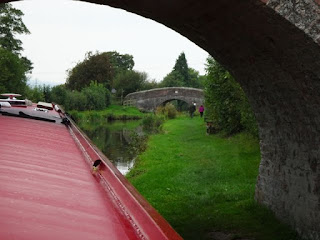 |
| Walking the towpath |
Although we are over here in the UK on a
Narrowboat holiday, a lot of our time is spent walking. Sometimes you must get
out and walk to operate the locks, raise lift bridges or check to see there are
no boats coming the other way on narrow sections, but often people are just out
walking because they enjoy it.
 |
| Under a bridge |
Almost everywhere there is a canal, there
is a “towpath” on one side of it. Originally the towpath was for the horses
which pulled the narrowboats before they had engines installed. These towpaths
go under the bridges, across the aqueducts and even through the shorter
tunnels. No longer used by horses, these paths are well used by not only
boaters, but also locals out for a stroll or walking their dogs, and often we
will be moored out in the countryside, seemingly in the middle of nowhere and
someone walking a dog will wander by the boat window.
Although the canals do run through cities,
generally they are out in the countryside and you pass more cows and sheep than
cars and trucks. Trees and hedges usually line the canals, so walking beside
the canal is a very pleasant experience. As well, a canal has to be flat, so
their routes were planned to never go over hills or into valleys. (The tunnels
and aqueducts do that) As a result, walking the towpath is a pleasant stroll
through the English countryside and there are no hills to climb. Most of us get
out and do at least four or five miles and some have done over twenty miles
every day, even in the “Welsh mist”. One of the crew, a non-fittbit-er has
probably done more, as they walked for the entire day.
 |
| The cows watch us pass |
You might ask why are we walking when we
paid for a boat hire. In fact while exploring the Great Orme in Llandudno, and
three of the crew took the tram up the mountain (Well more of a pretty big hill
. . . . ) and decided to get off in the middle and walk the second half,
another tram rider questioned them “But why walk? . . you paid for a ticket.” It is like that on the
boat. Often there are more people out walking than on the boat, because walking
the canals is a pleasant as gliding along in the boat.
















